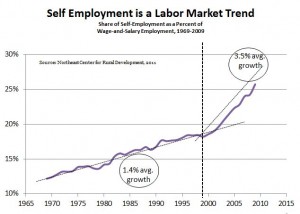San Francisco, CA (PRWEB) August 21, 2013
Very small businesses create the jobs. From 2004 to 2010, U.S. micro-businesses (1 to 4 employees) created a net of 5.5 million jobs; large businesses (those with greater than 500 employees) lost 1.8 million jobs during the same period.
Download more findings: Micro-businesses are the real job creators and the SBA data.
“This analysis points to a real strength of the American labor force,” says Claudia Viek, C.E.O. of CAMEO. “Micro-businesses are stronger than other sized businesses when it comes to job creation. Imagine how much stronger our economy could be if doubled our investment in micro-business development programs.”
“The first step to success for locally grown and start-up micro-businesses is business assistance: training and mentoring for new entrepreneurs,” says Claudia Viek, C.E.O. of CAMEO. “We surveyed our members, and found that when business owners receive business assistance, they have an 80% success rate and create two jobs on average over three-to-five years.”
It’s these business assistance programs, the programs that teach business owners to create a viable business model and write a well thought out business plan– that ensure the success of 88% of the nation’s businesses, or the 25.5 million businesses that are very small or micro-businesses with five or fewer employees. According to Association for Enterprise Opportunity, these businesses generate $2.4 trillion in receipts and account for 17% of GDP and employ more than 31 million people.
It’s common mantra by politicians to say that small business creates all the jobs, but small business has a broad definition of fewer than 500 employees. CAMEO, the California Association for Micro Enterprise Opportunity, used data from the Small Business Administration (table 2) to calculate the net new jobs by firm size. When small business is broken down by firm sizes (as measured by employees include: 1-4, 5-9, 10-19, 20-99, 100-499), the job creation numbers tell us that micro-businesses create all the jobs.
Very small businesses created jobs every year and mostly created more jobs than any other firm size. The only exception was in 2006 when micro-businesses created 1,001,960 jobs and large firms created 1,072,710 jobs. During 2009 and 2010, these micro-businesses were the only firm size that created jobs.
‘Micro-businesses as job creators’ also holds true across states. In 48 states, very small firms created more jobs than any other firm size; Alaska and New Hampshire were the only two states in which micro-businesses created few jobs than large businesses. For most states, other firm sizes lost jobs.
This analysis is more evidence that micro-business is the backbone of the economy.
 The Bureau of Labor statistics reported in March that the average size of new start-ups was 4.7 employees in 2011 – that’s down from 7.6 employees in the 1990’s. And the share of the self-employed in the labor market is growing exponentially (see graph). And the trend is expected to continue. Whether it’s the technological gains that allow high productivity or the disappearance of the ‘safe corporate job’, the reality is that businesses are starting smaller (and perhaps staying smaller).
The Bureau of Labor statistics reported in March that the average size of new start-ups was 4.7 employees in 2011 – that’s down from 7.6 employees in the 1990’s. And the share of the self-employed in the labor market is growing exponentially (see graph). And the trend is expected to continue. Whether it’s the technological gains that allow high productivity or the disappearance of the ‘safe corporate job’, the reality is that businesses are starting smaller (and perhaps staying smaller).
Despite the real trend toward self-employment and micro-business, most efforts to help entrepreneurs are focused on high growth businesses. Everyone wants to be the next Facebook, but only 1% of those businesses will actually scale and employ more than 10 people.
“Almost none of the policies for small business helps the real job creators, says Viek. “Micro-businesses don’t hire another person because of a tax credit or a visa, they hire another person because they have more business, more customers, more demand.”
ABOUT CAMEO
CAMEO is California’s statewide Micro Enterprise association made up of over 160 organizations, agencies and individuals dedicated to furthering Micro Enterprise development in California. In 2011, CAMEO members served 21,000 businesses with training, technical assistance and loans. These firms, which were largely start-ups, supported/created 37,000 new jobs into California’s economy and generated a total of $1.5 billion in economic activity– raising state revenues, decreasing demand for government services and putting more money into local and state economies. Federal taxes paid increased 35% over a five-year period.
